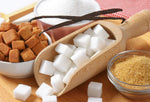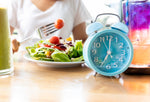On This Page
What Foods Contain Caffeine?
Our editorial process includes extensive measures to verify accuracy, provide clarity on complex topics, and present factual information. Read more
Does Decaffeinated Coffee Contain Caffeine?
Despite the name, decaffeinated coffee still contains trace amounts of caffeine that may result in side effects if you’re sensitive to caffeine. While the exact amount may vary depending on the brand and the strength of the brew, you can expect to find around 5 milligrams of caffeine in an 8-ounce cup of decaf coffee.
For comparison, an 8-ounce cup of regular coffee contains 95 milligrams, and one ounce of espresso contains 63 milligrams of caffeine. Black tea can also contain 48 milligrams of caffeine per 8 ounces, so if you’re looking for a calming drink before bed, you may want to reach for a caffeine-free herbal tea instead.
Do Sugary Drinks Contain Caffeine?
You may expect energy drinks and guarana to have caffeine in them, but you’ll also find this energizing substance in seemingly caffeine-free drinks such as certain sodas or flavored milk. Drinks like Coca Cola and Mountain Dew contain between 20 milligrams and 40 milligrams of caffeine per 8 ounces.
Overall, soft drinks account for about 16% of caffeine consumption in the United States, and they are more popular with younger consumers. Because these drinks also tend to be high in sugar, they should be consumed in moderation and they’re not the best choice if you want to relax before bed.
Does Chocolate Have Caffeine?
Cocoa beans naturally contain a fairly high amount of caffeine. As a benchmark, dark chocolate with a cocoa content of 60% to 70% contains about 86 milligrams of caffeine per 100 grams. The darker the chocolate, the higher the cocoa content and the more caffeine present. If you have a sweet tooth after dinner, white chocolate may be a better choice.
Some examples of chocolate-flavored foods that contain caffeine include hot chocolate, breakfast cereals, ice cream, and candy bars. These foods have a proportional amount of caffeine depending on their cocoa content. For example, 100 grams of chocolate cake with chocolate frosting has about 6 milligrams of caffeine, while chocolate ice cream contains just 3 milligrams per 100 grams.
Is There Caffeine in Coffee-Flavored Confections?
Coffee-flavored ice cream can actually pack a significant amount of caffeine. Energy bars have also been known to use caffeine for an added boost, especially chocolate- or coffee-flavored options.
Does Medication Contain Caffeine?
Despite popular wisdom that caffeine can worsen premenstrual symptoms, newer research suggests it may not be as harmful as previously thought. In fact, some medications marketed for relief from premenstrual symptoms include caffeine, which is used to reduce bloating and fatigue. Caffeine is also sometimes added to dietary supplements and pain relievers, such as headache medication.
Should I Avoid Foods With Caffeine?
If you are sensitive to caffeine or if you struggle with insomnia, it’s helpful to have some knowledge of which substances to avoid. To be on the safe side, try to steer clear of caffeine within four to six hours of bedtime. Children, older adults, pregnant women, and other vulnerable populations should take extra care when consuming caffeine.
For most people, a few pieces of chocolate or a pain reliever aren’t likely to contain enough caffeine to significantly affect sleep quality. That said, following a mindful diet can help you sleep better and may even help you avoid bad dreams.










